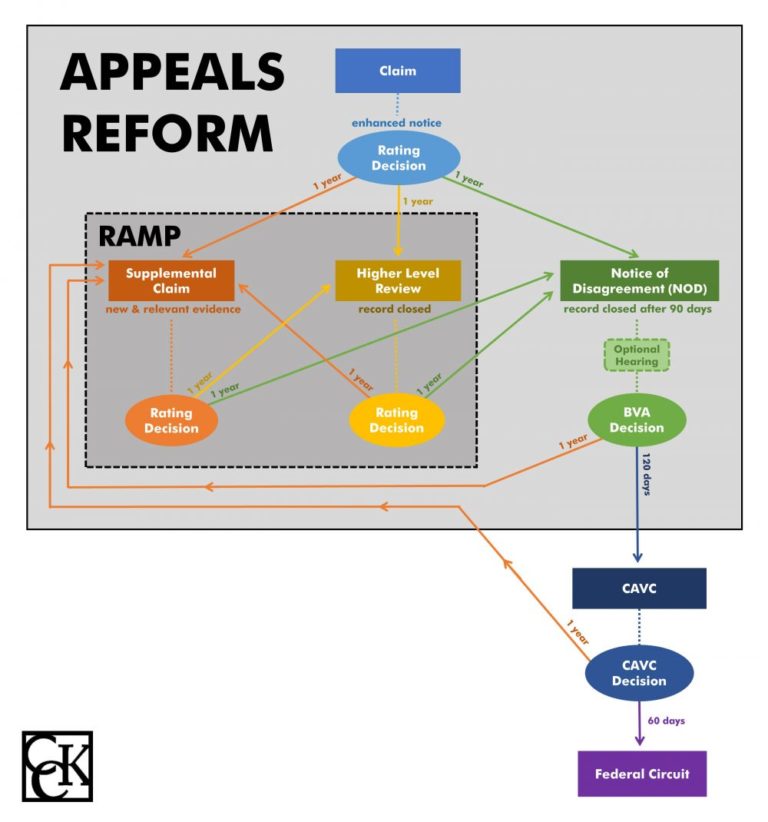VA Disability Benefits Appeals Reform: the New Claim Stream

The VA disability claims process is undergoing significant changes as it prepares for the full implementation of the Veterans Appeals Improvement and Modernization Act of 2017 (Appeals Reform) in February 2019. Under Appeals Reform, the process for appealing VA benefits decisions is drastically different than the process under the current system, known as the Legacy appeals system. VA is hopeful that the new system will help deliver decisions in a more efficient and effective manner.
Legacy Appeals System: Claim Stream
The current Legacy appeals system only involves one “lane” in the veterans’ claims process. In other words, all veterans filing for VA disability benefits go through the following steps:
- Veteran files a claim
- Local Regional office will issue a Rating Decision that grants, denies, or partially grants the claim
- Veteran has one year to file a Notice of Disagreement (NOD)
- Veteran then waits for a Statement of the Case (SOC), explaining why the claim was denied or only partially granted
- Veteran has 60 days from when VA issues the SOC to file a VA Form 9 Substantive Appeal to the Board of Veterans’ Appeals
- The Board will then issue a decision granting, denying, or remanding the case for further action
- If a veteran is appealing a further denial, he or she has 120 days to appeal to the Court of Appeals for Veterans Claims
However, the new system under Appeals Reform offers more choice for veterans when it comes to handling disagreements with VA’s decisions.
Appeals Reform: Claim Stream
Under Appeals Reform, there will still be a Rating Decision after every claim is filed. However, if a veteran disagrees with VA’s decision, he or she has one year to appeal by choosing one of the following three lanes:
- Higher-Level Review Lane. The veteran requests that a more experienced rating specialist issues another decision. In this lane the record is closed, meaning the veteran cannot submit any additional evidence.
- Supplemental Claim Lane. The veteran can submit new and relevant evidence in support of his or her claim.
- Notice of Disagreement Lane. The veteran can appeal his or her case directly to the Board. There are an additional three lanes at the Board that veterans can choose from: direct docket, hearing docket, and evidence docket. In the direct docket, the Board considers only the evidence that was of record at the time of the prior agency of original jurisdiction decision. The hearing docket closes the record 90 days from the Board hearing. For the evidence docket, the record is closed 90 days after the veteran files the Notice of Disagreement.
After appealing through one of those three lanes, the veteran will then receive another decision. Specifically, both the higher-level review and supplemental claim lanes will yield additional Rating Decisions while the Notice of Disagreement lane will produce a Board decision.
- Higher-Level Review Rating Decision. If a veteran receives an unfavorable Rating Decision in the higher-level review lane, he or she has one year to file either a supplemental claim or a Notice of Disagreement. A veteran cannot request higher-level review of a decision that came from within the higher-level review lane.
- Supplemental Claim Rating Decision. If a veteran receives an unfavorable Rating Decision in the supplemental claim lane, he or she has one year to file an appeal in any one of the three lanes available. Importantly, there is no limit on the number of supplemental claims a veteran files, but he or she must submit new and relevant evidence in order to do so.
- Board Decision. If a veteran receives an unfavorable Board decision, he or she can either file a supplemental claim within one year or appeal to the CAVC within 120 days. Here, the option for higher-level review is unavailable because the Board is the highest level of review within VA. If a veteran disagrees with a CAVC decision, he or she can submit a supplemental claim within one year or appeal to the Federal Circuit within 60 days.
Switching Lanes Under Appeals Reform
Importantly, veterans can withdraw their request for a certain review option at any time prior to VA issuing a decision on their claim. If the veteran’s withdrawal occurs within the one-year period following the date VA issued the decision being reviewed, the veteran can choose another review option and their effective date will be preserved.
Final Decisions
Under the Legacy system, decisions became final when the appeal period for that decision passed without the veteran filing the appropriate appeal. The new regulations under Appeals Reform are similar: a decision will become final if the veteran does not appeal within one year of the date of the decision. The main difference between the Legacy system and Appeals Reform is that veterans will have one year to appeal no matter what type of decision they receive, whether it is a higher-level review decision, a Board decision, a supplemental claim decision, or even a CAVC decision. The only exception is if a veteran chooses to appeal to a higher court outside of VA. Specifically, if a veteran appeals a Board decision to the CAVC, or a CAVC decision to the Federal Circuit, then the timeframe to do so will be more limited as outlined above.
When a decision becomes final, veterans will lose their effective date since the claim will no longer be continuous.
About the Author
Share this Post
